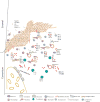Inflammatory and immune pathways in the pathogenesis of periodontal disease
- PMID: 24320956
- PMCID: PMC4500791
- DOI: 10.1111/prd.12002
Inflammatory and immune pathways in the pathogenesis of periodontal disease
Abstract
The pathogenesis of periodontitis involves a complex immune/inflammatory cascade that is initiated by the bacteria of the oral biofilm that forms naturally on the teeth. The susceptibility to periodontitis appears to be determined by the host response; specifically, the magnitude of the inflammatory response and the differential activation of immune pathways. The purpose of this review was to delineate our current knowledge of the host response in periodontitis. The role of innate immunity, the failure of acute inflammation to resolve (thus becoming chronic), the cytokine pathways that regulate the activation of acquired immunity and the cells and products of the immune system are considered. New information relating to regulation of both inflammation and the immune response will be reviewed in the context of susceptibility to, and perhaps control of, periodontitis.
© 2013 John Wiley & Sons A/S. Published by John Wiley & Sons Ltd.
Figures

References
-
- Alexopoulou L, Holt AC, Medzhitov R, Flavell RA. Recognition of double-stranded RNA and activation of NF-kappaB by toll-like receptor 3. Nature. 2001;413:732–738. - PubMed
-
- Anderson DM, Maraskovsky E, Billingsley WL, Dougall WC, Tometsko ME, Roux ER, Teepe MC, DuBose RF, Cosman D, Galibert L. A homologue of the TNF receptor and its ligand enhance T-cell growth and dendritic-cell function. Nature. 1997;390:175–179. - PubMed
-
- Anderson KV. Toll signaling pathways in the innate immune response. Curr Opin Immunol. 2000;12:13–19. - PubMed
-
- Appay V, van Lier RA, Sallusto F, Roederer M. Phenotype and function of human T lymphocyte subsets: consensus and issues. Cytometry A. 2008;73:975–983. - PubMed
-
- Ara T, Kurata K, Hirai K, Uchihashi T, Uematsu T, Imamura Y, Furusawa K, Kurihara S, Wang PL. Human gingival fibroblasts are critical in sustaining inflammation in periodontal disease. J Periodontal Res. 2009;44:21–27. - PubMed
Publication types
MeSH terms
Substances
Grants and funding
LinkOut - more resources
Full Text Sources
Other Literature Sources
Medical

